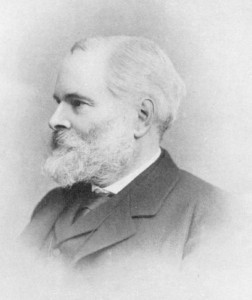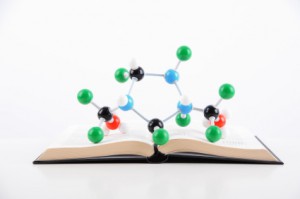One day while reading a knitting blog I discovered in 1883 a Scottish chemist created the first “ball-and-stick” model of a molecule using knitting needles and balls of yarn. This initial ball-and-stick molecule represents the structure of sodium chloride and is constructed of knitting needles, representing the bonds, and alternating balls of blue and red yarn, representing the atoms of sodium and chloride. It was displayed as part of the International Year of Chemistry 2011 activities.
The chemist who created this model was Alexander Crum Brown, distinguished chemistry and professor at the University of Edinburgh, and one of his particular interests was the arrangements of atoms in molecules and the depiction of these structures. Those of us who spent countless hours poring our organic chemistry books and molecular model sets trying to understand nucleophilic attacks and SN1 and SN2 reactions have Alexander Crum Brown to thank. Those students who now use computer 3D modeling programs to accomplish the same studies (without the delight of chasing down the last nitrogen atom that has rolled off the desk and under the dresser) are also indebted to Dr. Brown.
In fact, even Watson and Crick are deeply in debt to Dr. Brown, for without his work to develop ball-and-stick modeling of chemical structures, they would not have been able to combine their knowledge of Chargaff’s rules and Franklin’s X-ray crystallography structures to propose their molecular model of the B form of DNA.

That a chemist from Scotland, the land of sheep, wool and Fair Isle Knitting, would have an deep-seeded interest in knots and knitting is not surprising. But it is a delightful find for this scientist knitter to see that he combined his knitting talents with his love of chemistry to do something that has become such a foundation of chemistry today—create a ball-and-stick molecular model. Who knew that knitting could drive scientific discovery and teaching?
So, I wonder is some additional chemistry knitting in order for scientists who knit? Perhaps some of the many scientific knitters around will decide to start knitting at scientific conferences or just create charts for knitting a favorite molecule. Do you have a favorite science knitting pattern? Share it in the comments below.
This blog last updated in 2020.
Related Posts
Michele Arduengo
Latest posts by Michele Arduengo (see all)
- IL-6/STAT3-Regulated Long Non-Coding RNA Is Involved in Colorectal Cancer Progression - July 1, 2025
- Using Dual-Luciferase Assays to Identify the Role of Non-Coding RNAs in Disease - May 2, 2025
- An Unexpected Role for RNA Methylation in Mitosis Leads to New Understanding of Neurodevelopmental Disorders - March 27, 2025

